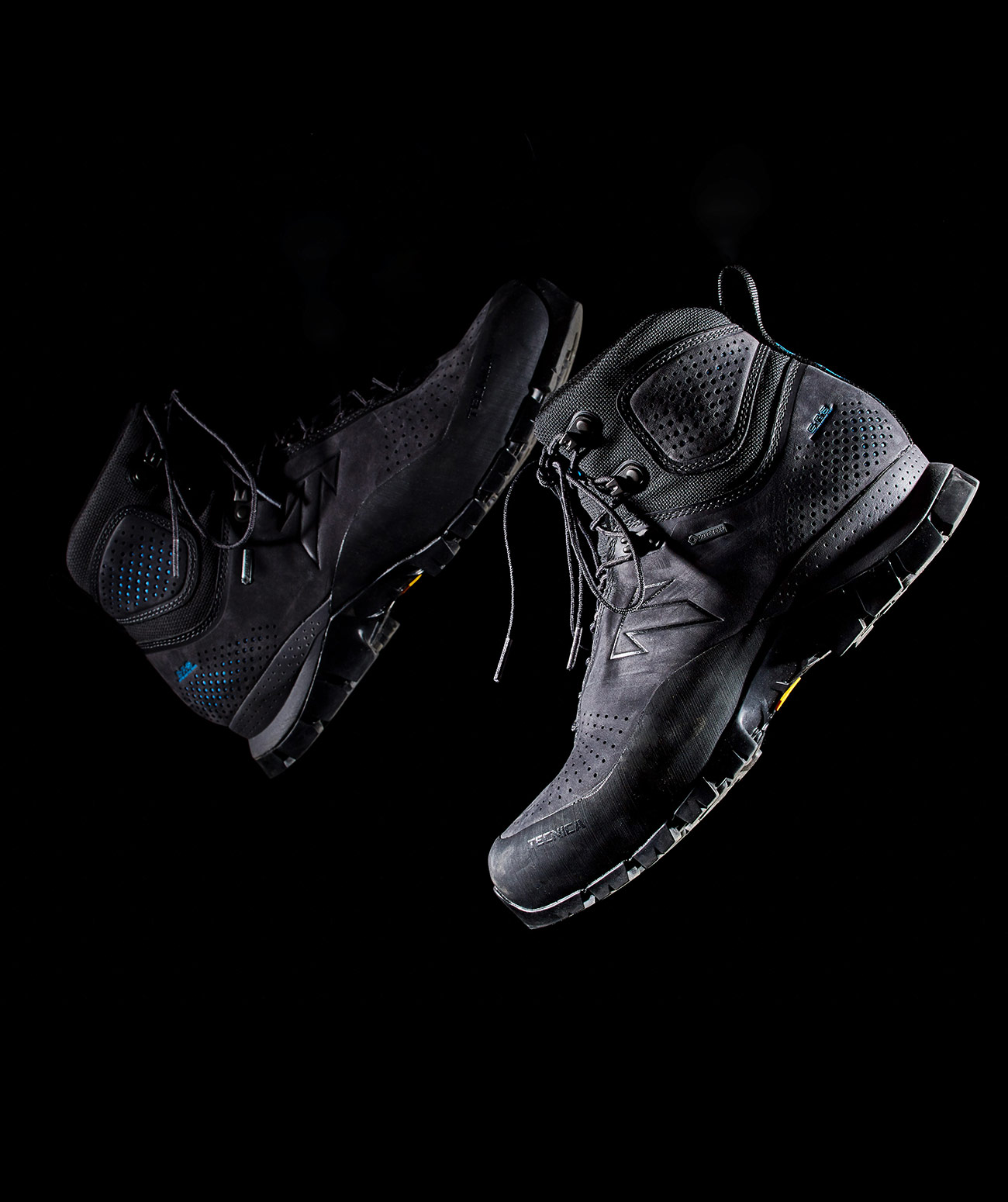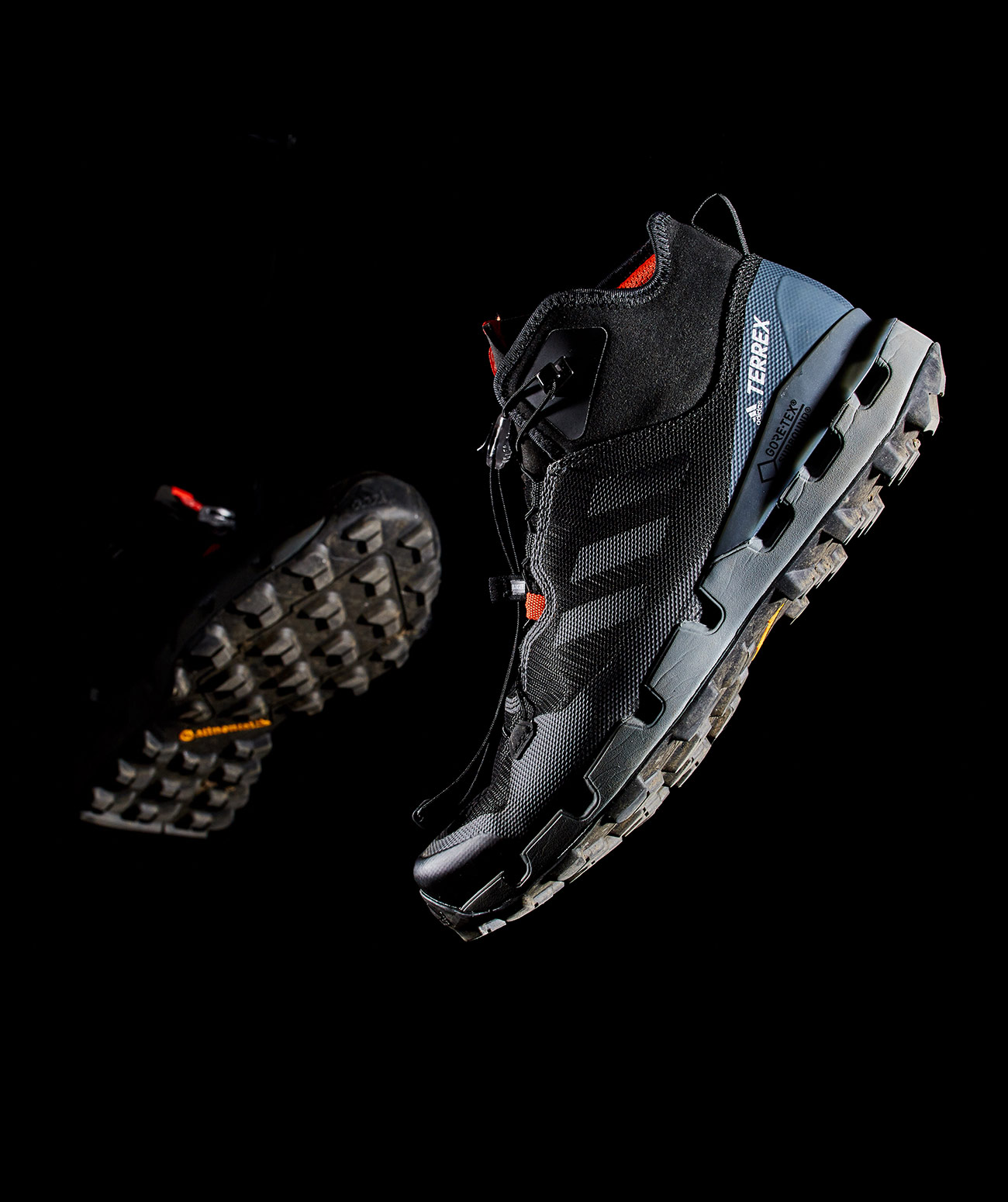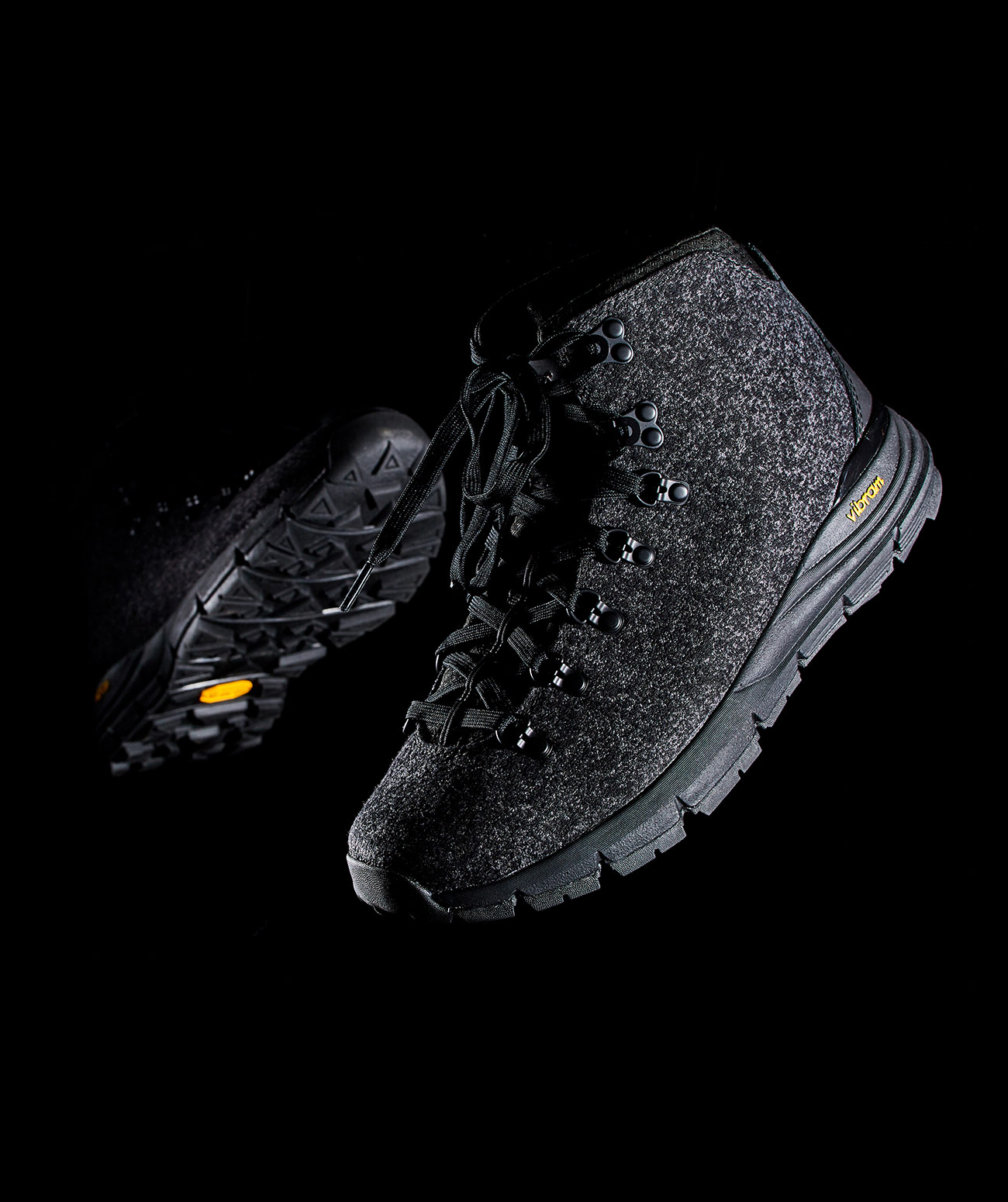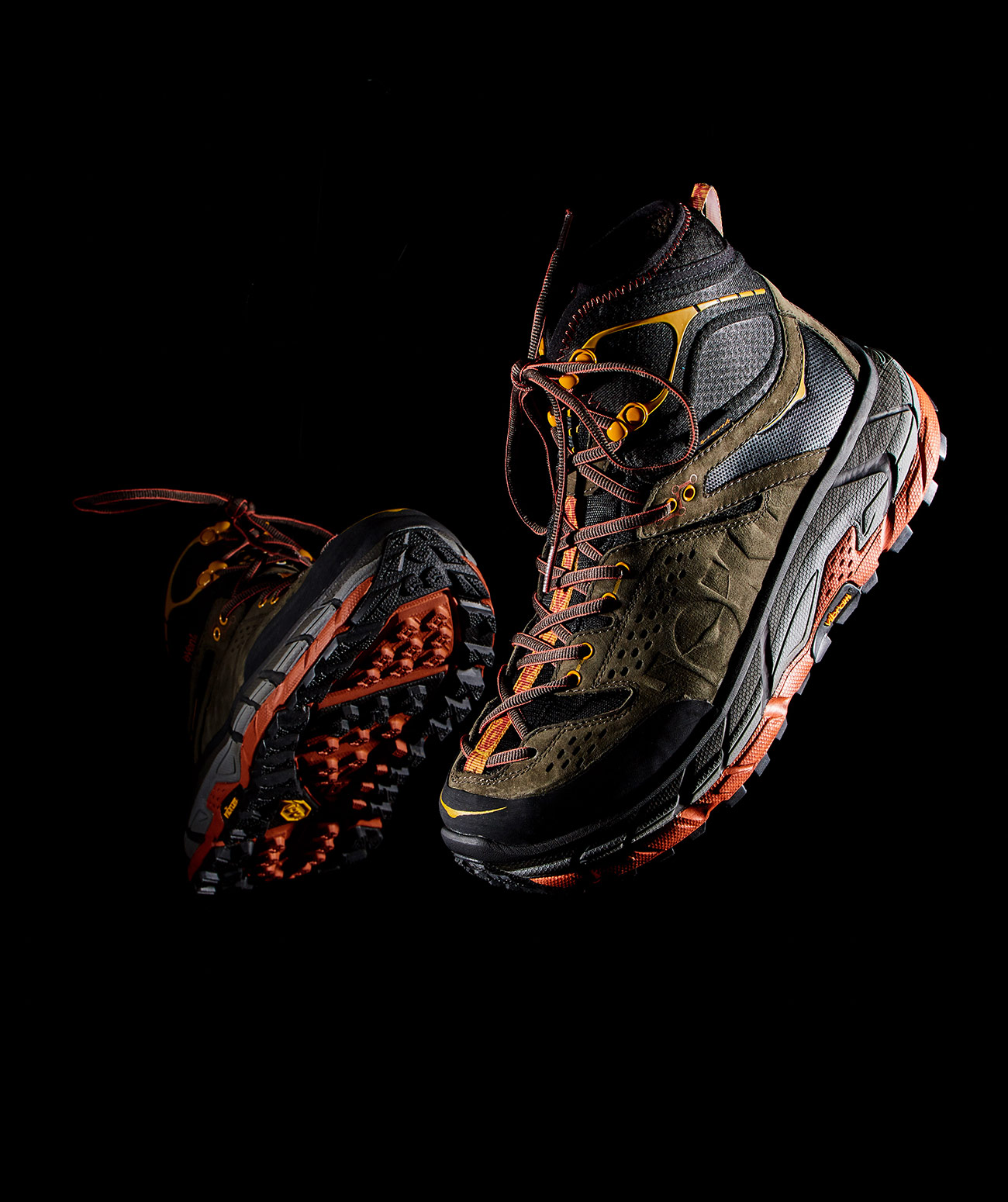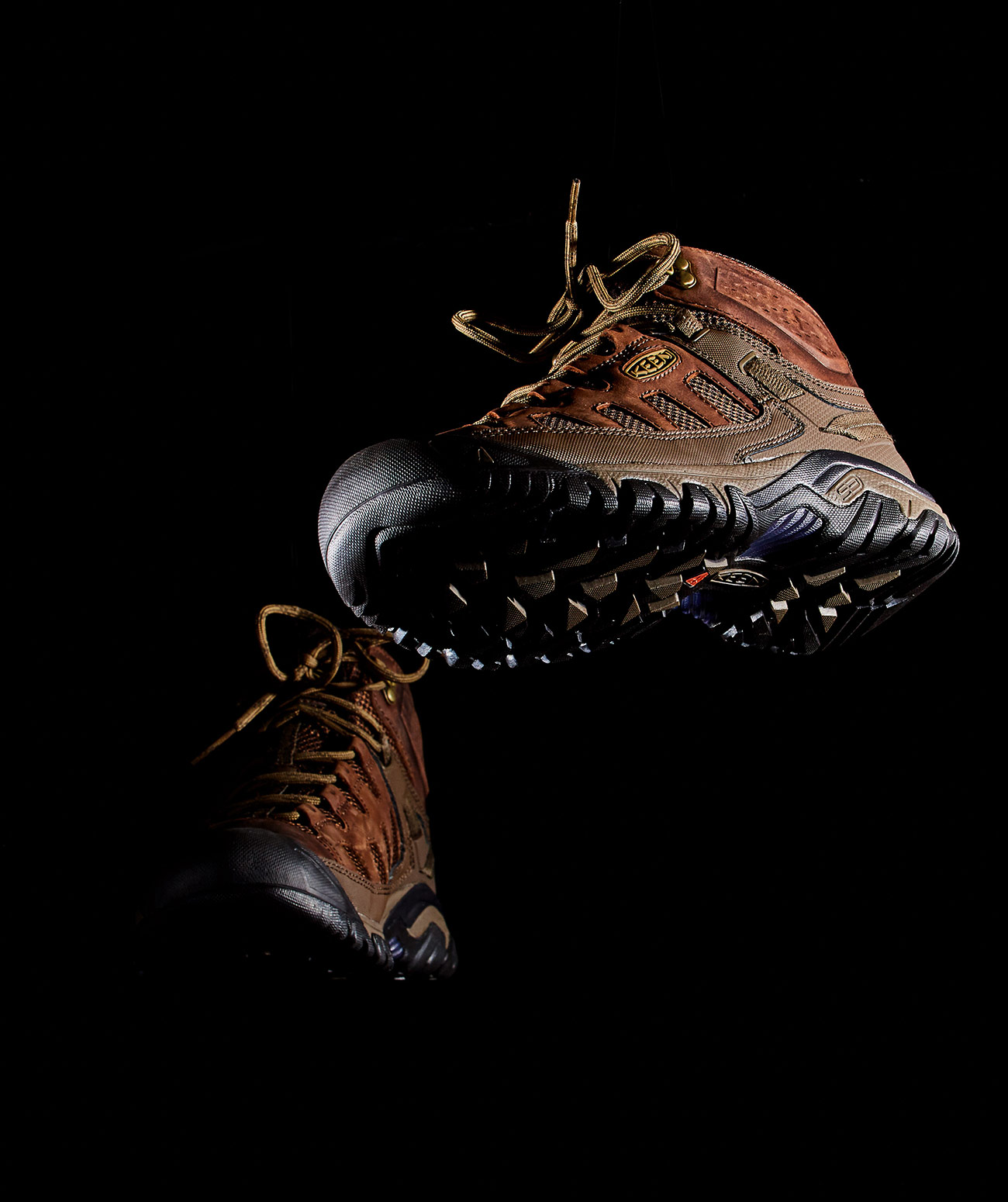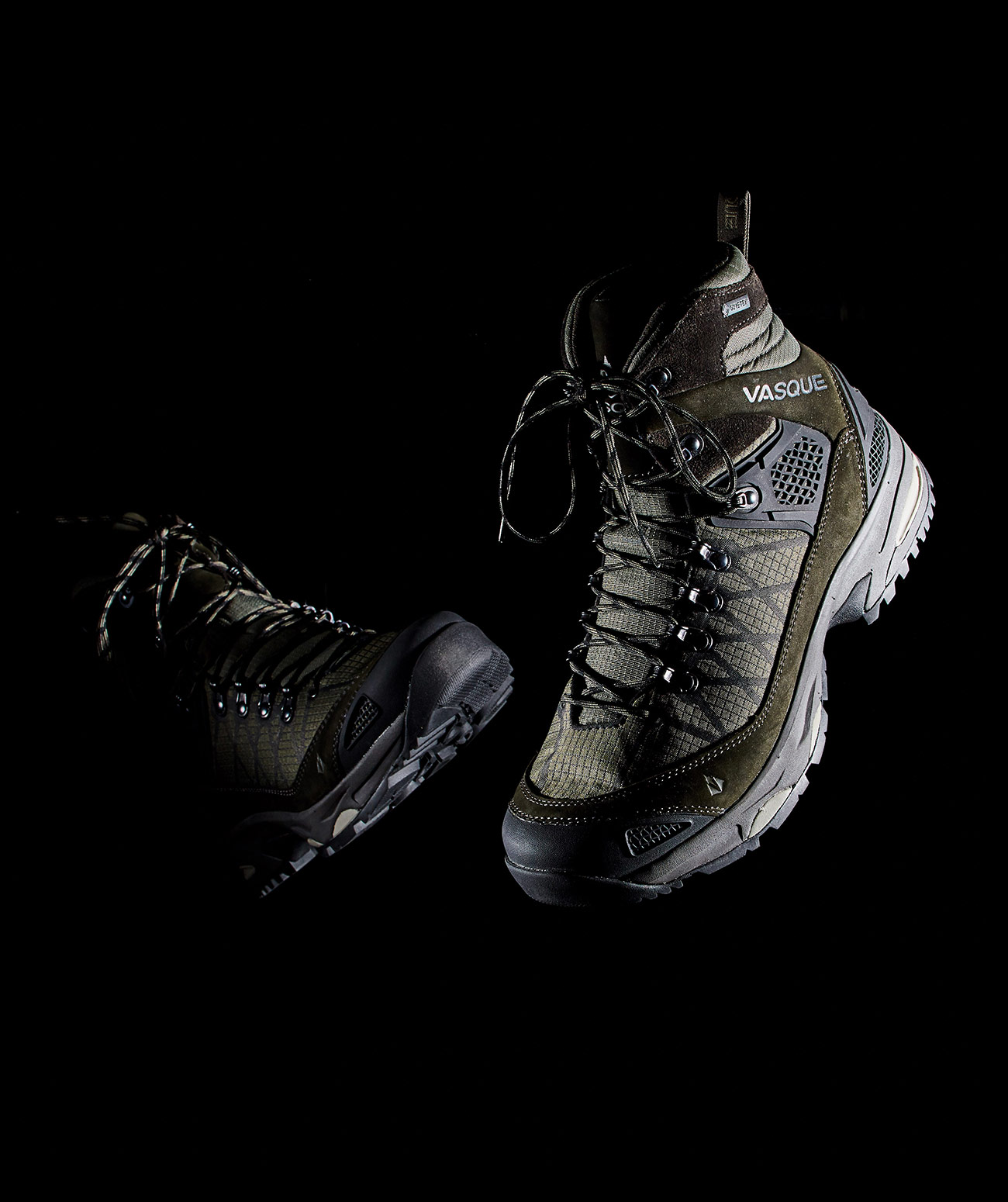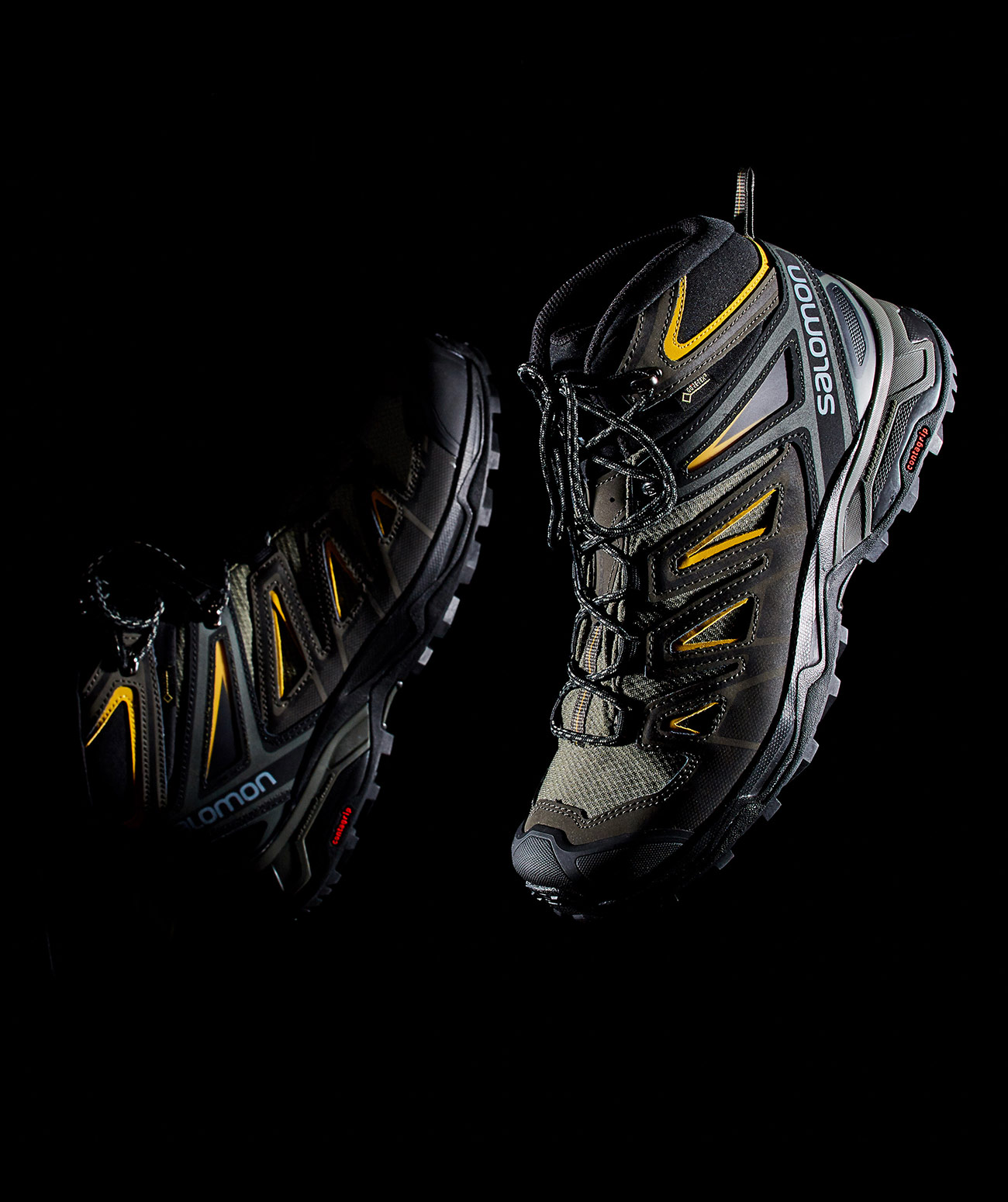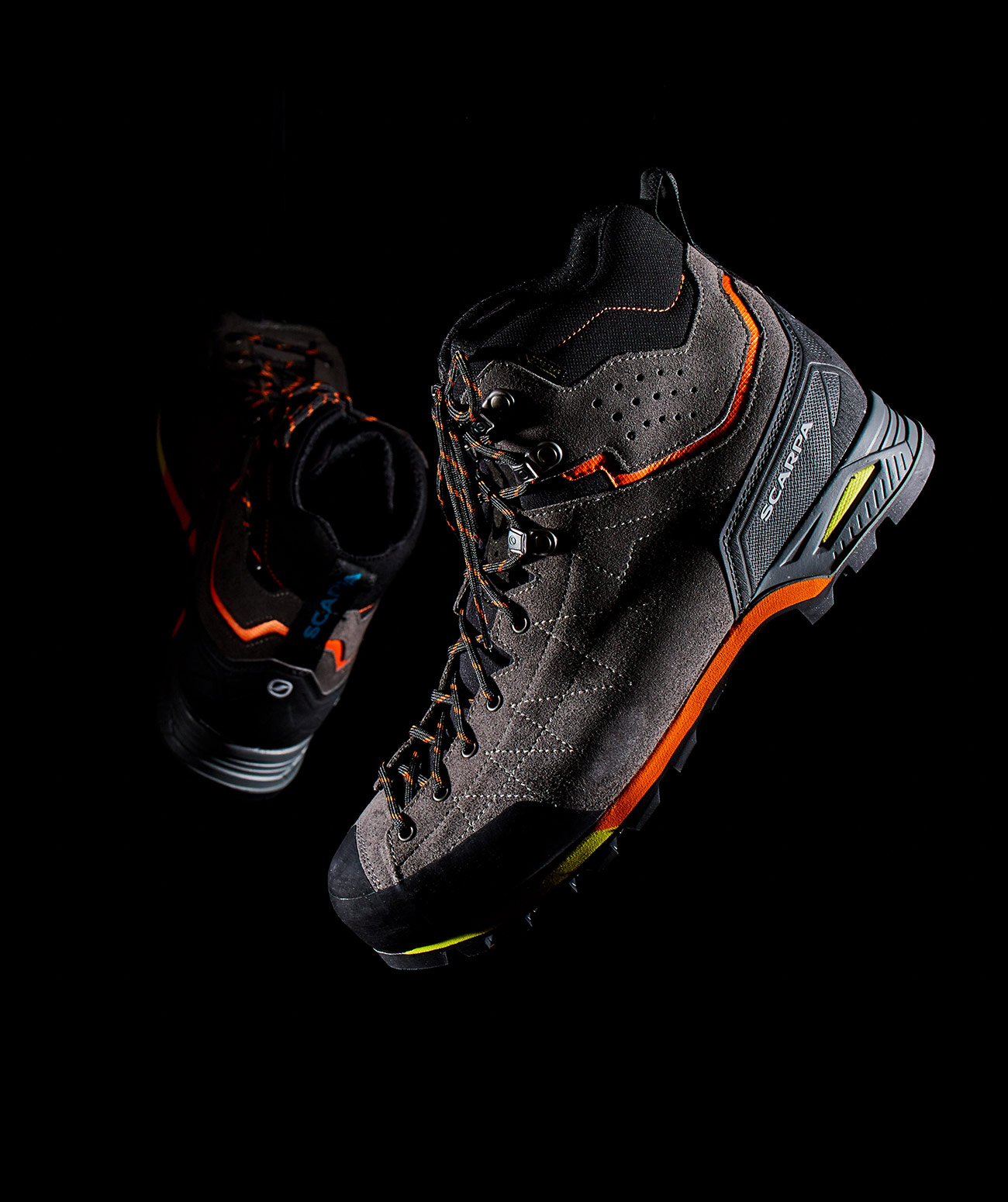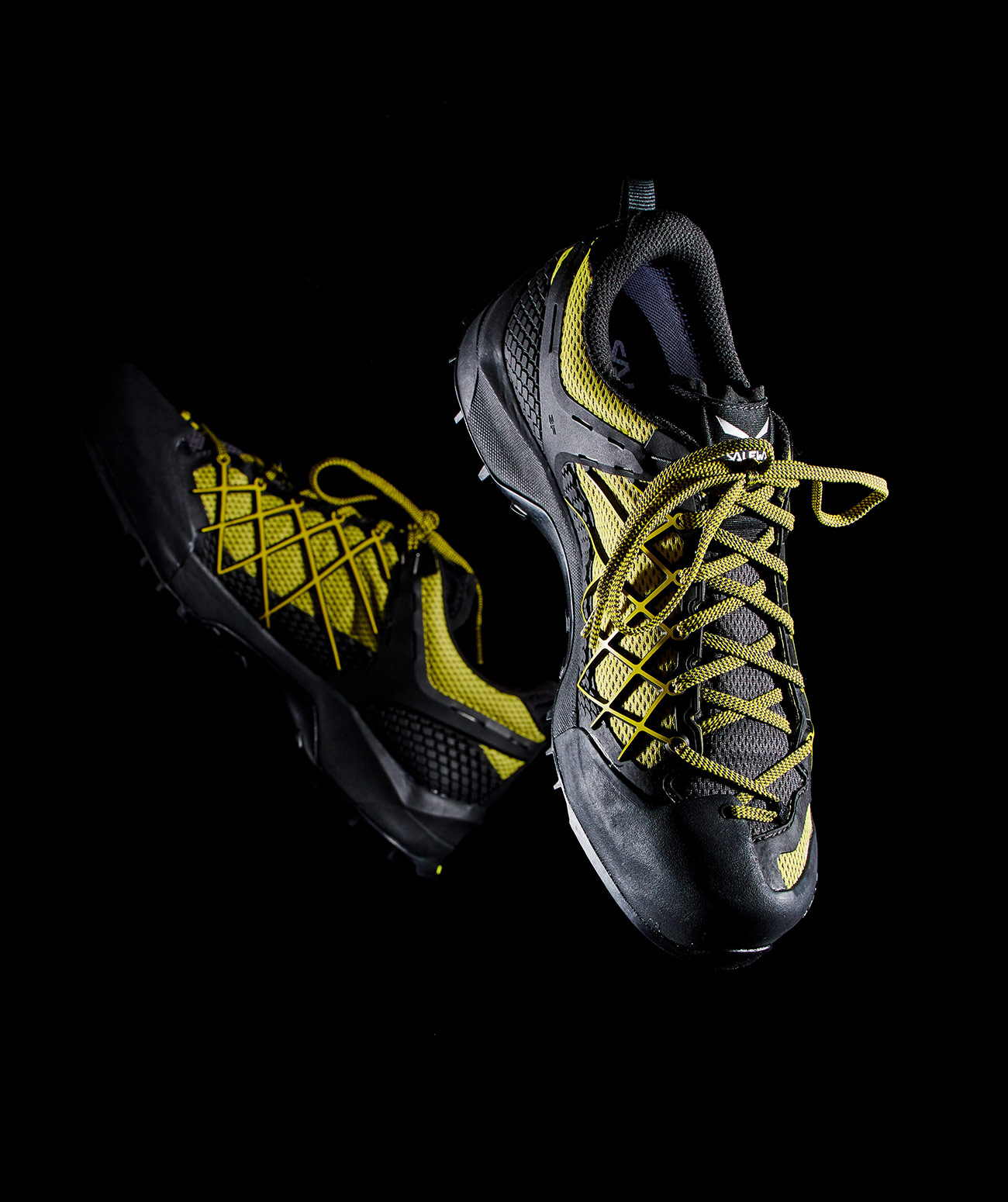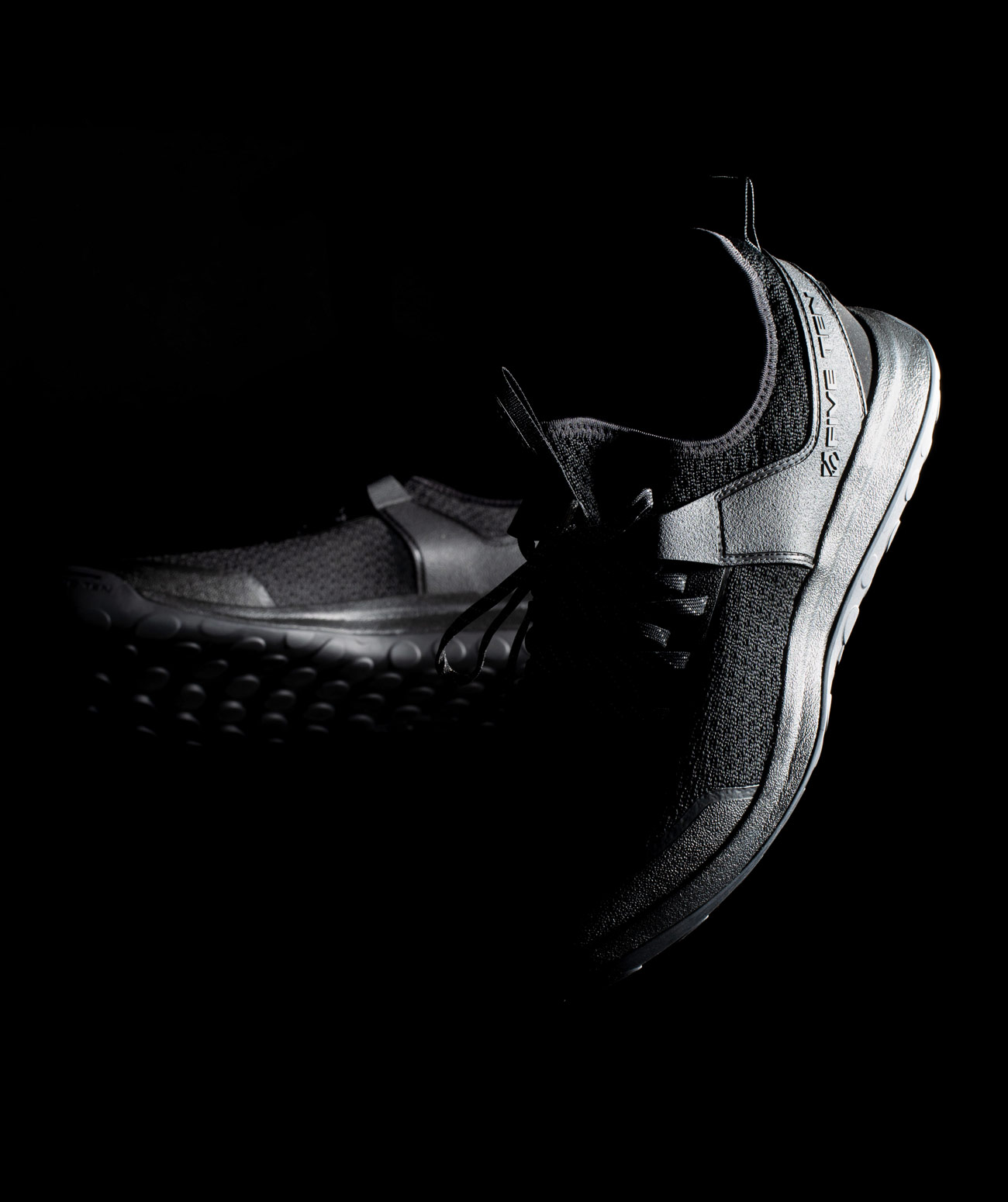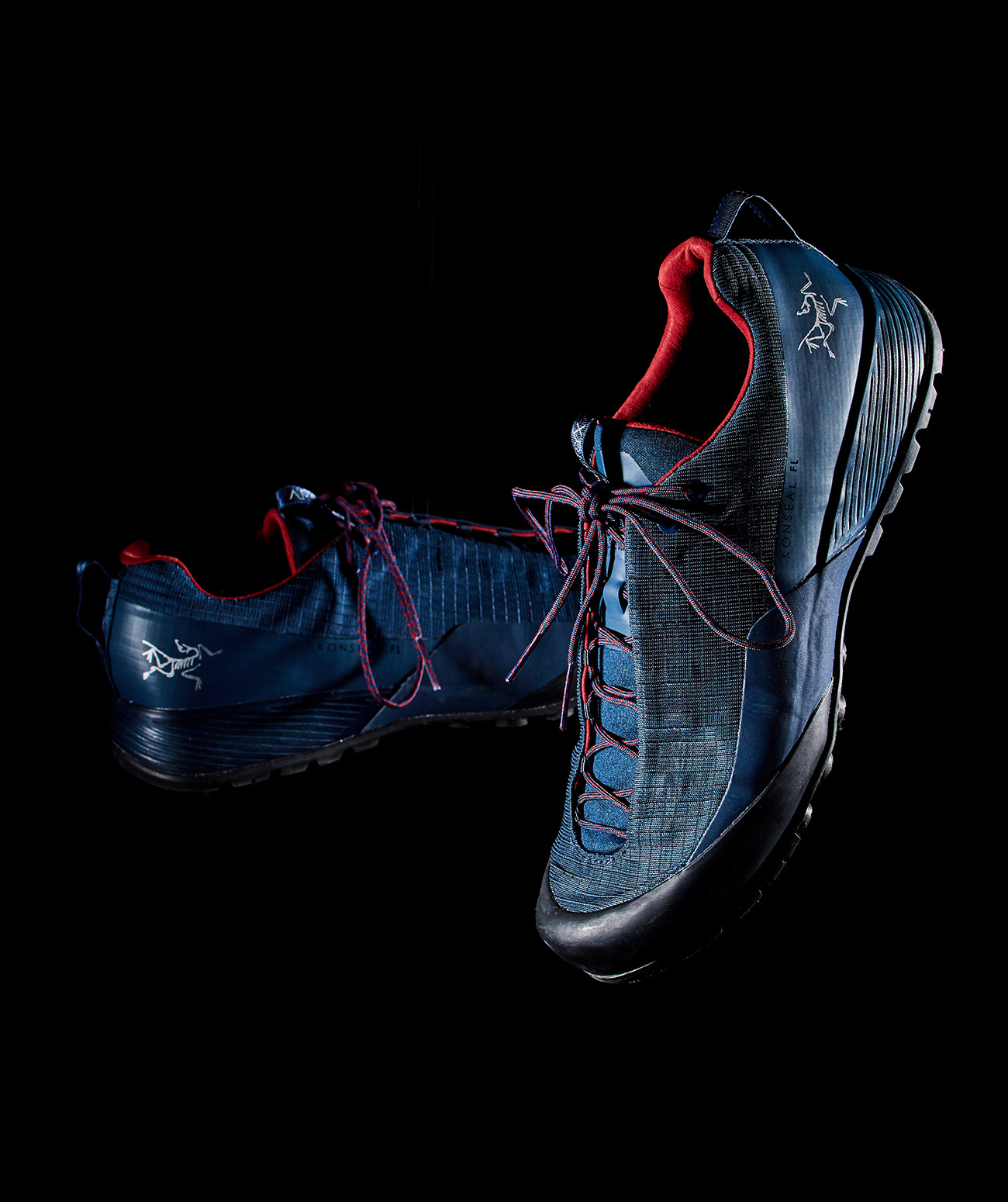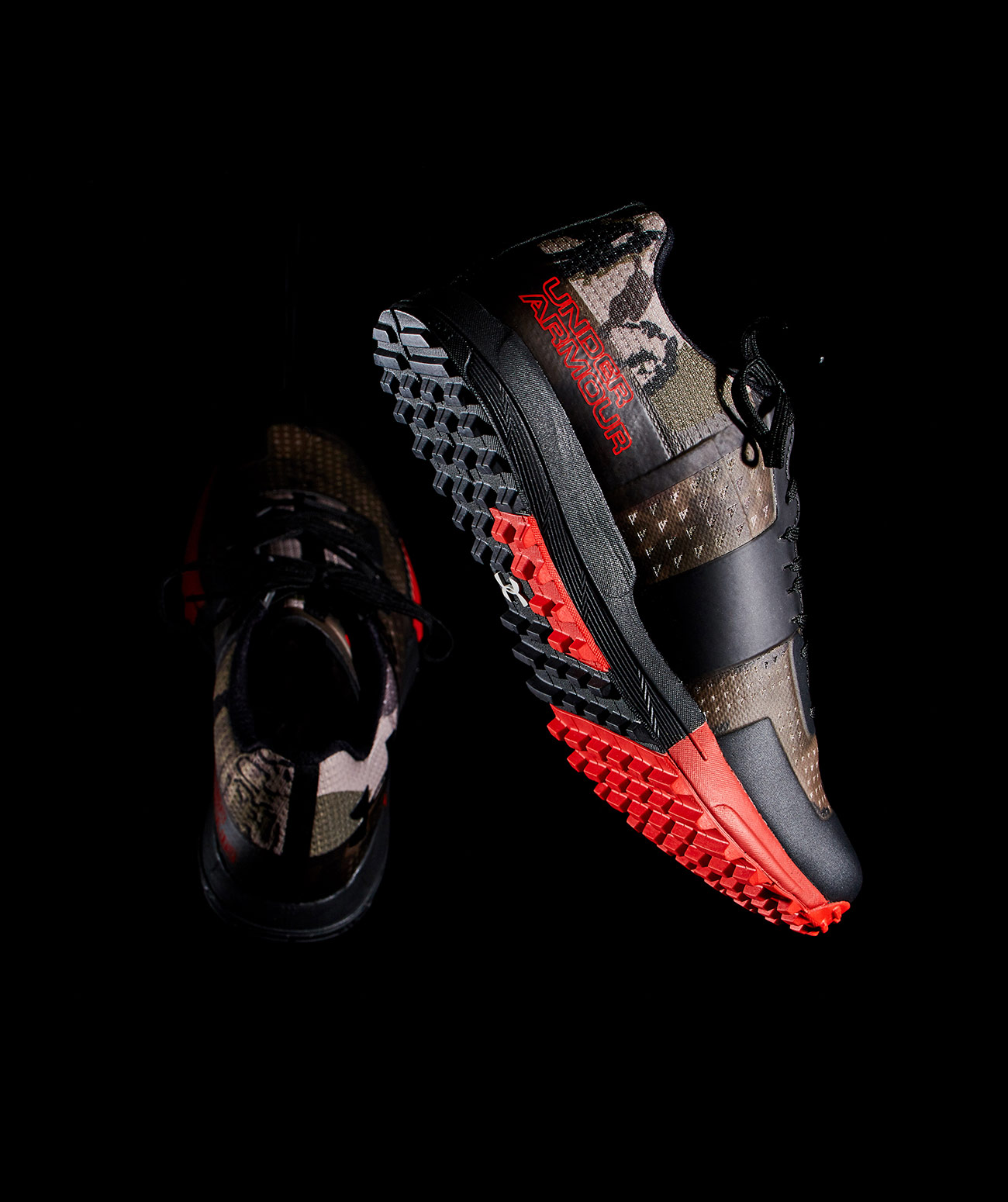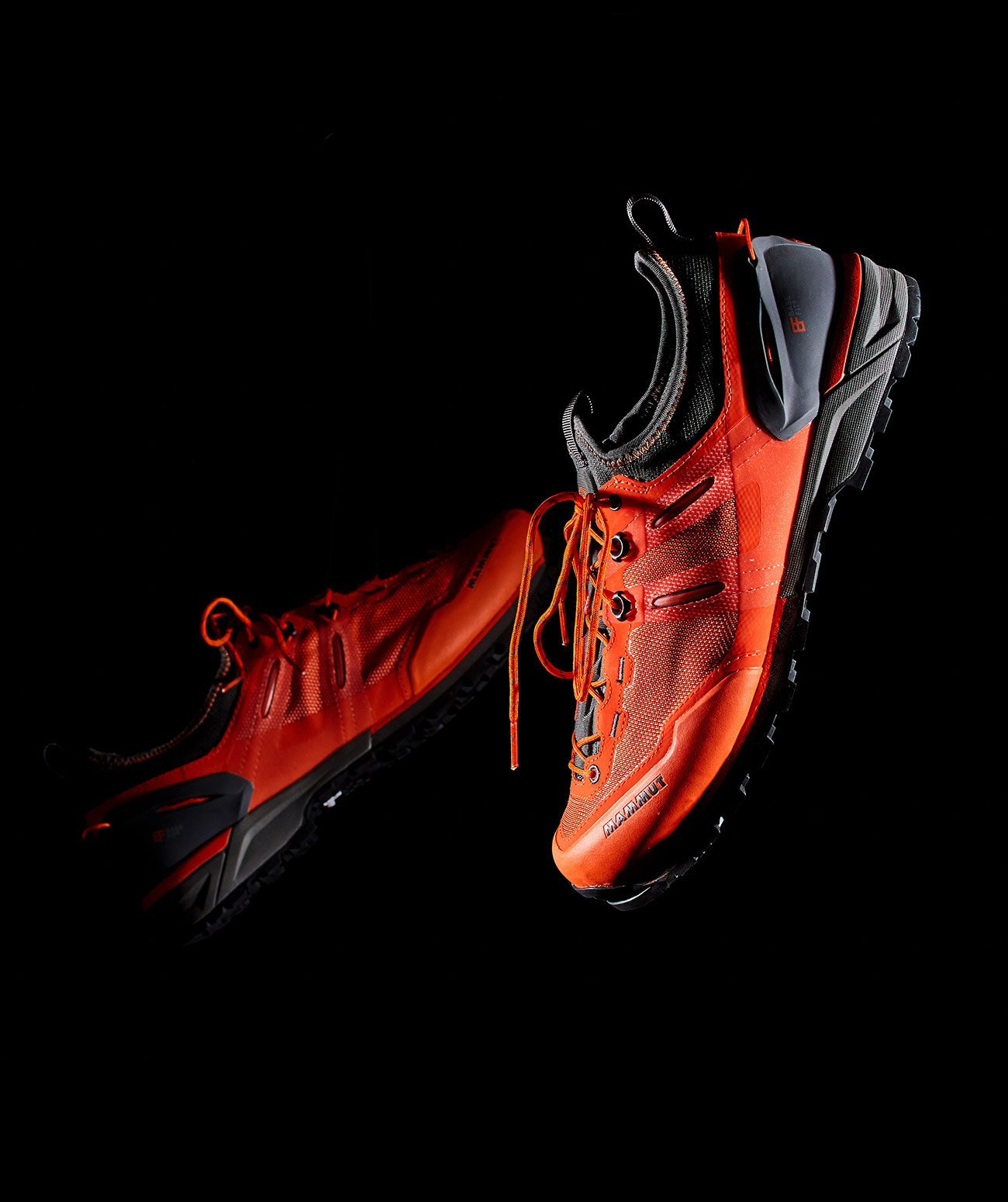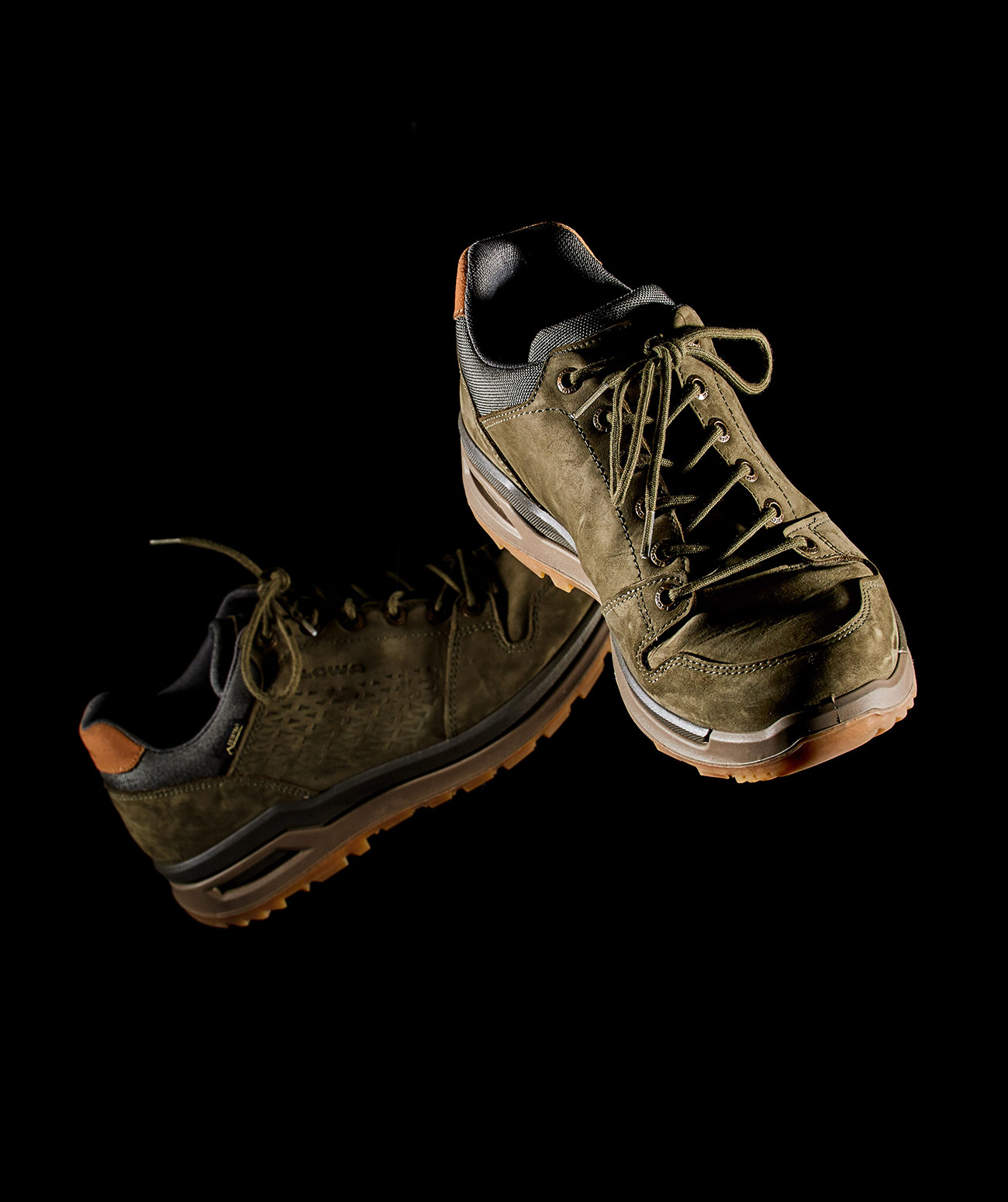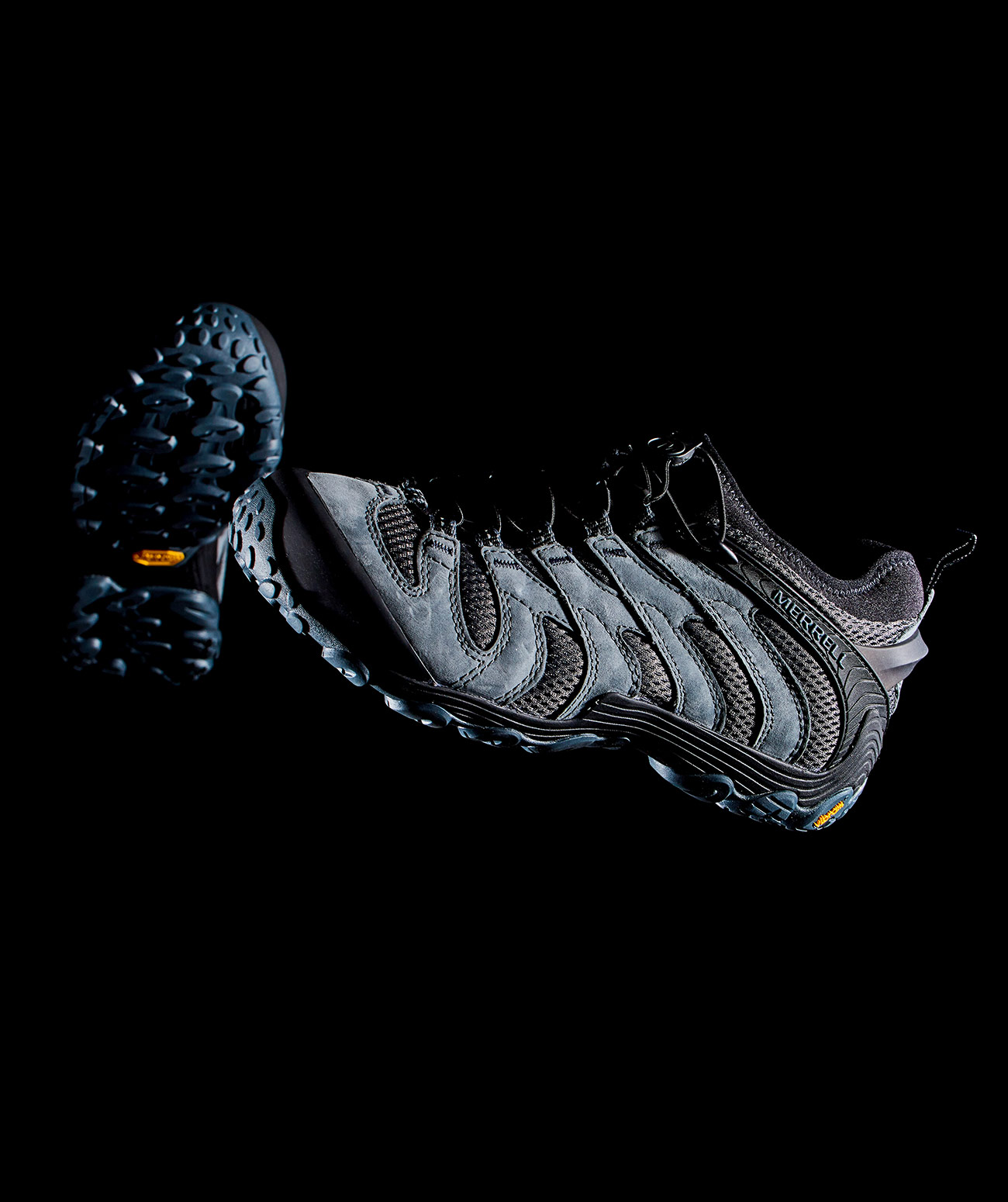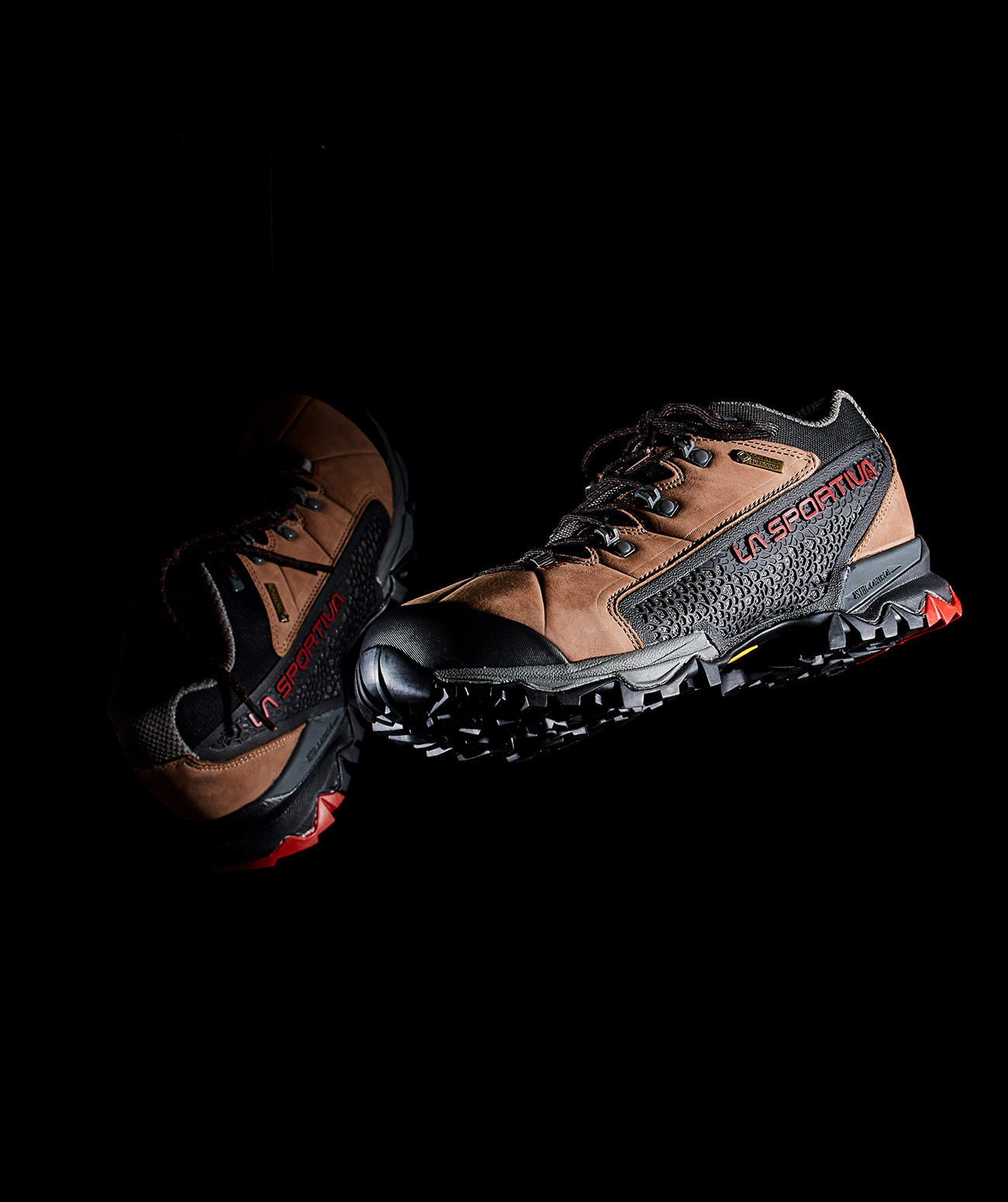Last updated June 2018: This guide to the best hiking boots of 2018 provides information on ten hiking boots and eight hiking shoes, and offers tips and advice to know before you buy.
Introduction
Hiking is an activity with a low barrier to entry; all one really needs to head out for a day in the woods is a pair of sturdy shoes and a mindset for walking. Both are equally important, but one is far easier to come by. And while it may be tempting to head out for a summit bid in a pair of well-worn running shoes, it’s best advised to shod yourself the appropriate footwear. Unlike concrete sidewalks and gravel paths, the trail calls for hardened and supportive footwear to combat dirt, mud, jagged rocks and streams. The answer is hiking boots and hiking shoes, and these are the best available.
About Fit
This guide is designed to be a resource that can help you find the best hiking boots available. Hours of research and wear-testing were undertaken to make sure that the hiking boots and shoes found here are actually pieces of high-quality footwear.
That being said, every person’s needs and walking habits are different, and more importantly, every person’s feet are different. What works for us may not work for you, and while we’ve provided as much variety here as we can, a review isn’t a substitute for trying a shoe on and making sure that it fits and is comfortable.
Hiking Boots vs. Hiking Shoes
There are two types of footwear made for logging trail miles: hiking boots and hiking shoes. Hiking boots are full-sized footwear made with stability and support in mind. When you’re backpacking, or you’re just taking on black diamond terrain during a day hike, hiking boots are there to lend more ankle support and reinforced protection.
Hiking shoes don’t offer the same level of ankle support that a cuff provides, they’re designed to be lightweight for nimble mobility. Most hiking shoes still give more support than a running shoe, plus a durable rubber sole with lugs that will maintain grip through varying terrain. Hiking shoes are a good option for those who prefer short walks and don’t need the extra support, and they’re a great option for travel too.
Should You Buy an Aftermarket Insole?
The short answer is yes. Almost every hiking boot and hiking shoe come with a foam insole that will wear out after very few uses. Some are better than others, and most will feel comfortable straight out of the box, but none will provide the long-term support of an aftermarket insole.
Superfeet makes a variety of affordable insoles that offer different volumes and levels of support. As with the boots themselves, it’s best to try these on at a store to find the most comfortable and best-fitting option. Bring your boots with you, because insoles can change the amount of space inside your shoe and affect the overall feel of its fit.
The Best Hiking Boots of 2018
Editor’s Pick: Tecnica Forge
The Forge is the first hiking boot from ski boot manufacturer Tecnica, and it’s also the first hiking boot that’s fully customizable. Every piece of the Forge is designed for customization, most notably so the upper, which is available in both synthetic ripstop and nubuck leather. In addition to that, Tecnica equipped the Forge with all the indications of a solid hiking boot, including a Gore-Tex liner and Vibram rubber sole.
Because the Forge is a full-custom boot, buying options are limited to the brick-and-mortar stores that keep it and its boot-fitting robot in stock. The typical fit process that involves trying on multiple pairs of boots and walking up and down a ramp covered fake rock doesn’t apply here because the boot feels remarkably different before and after molding. That process takes about 20 to 30 minutes and involves two rounds of heating and molding, one for the Forge’s insoles and another for the uppers.
The result of that is about as good a fit as a hiking boot can achieve, and it doesn’t come with a rigorous break-in period either. That alone should make the Forge an attractive choice for many, and it’s not the only feature that makes it a great hiking boot. The Vibram sole is appropriately rugged, the wrap-around cuff is comfortable and supportive, and the upper is waterproof but breathable. For its first foray into a new category, Tecnica hit the mark.
Weight: 20.9 ounces (leather) 20.6 ounces (synthetic
Waterproofing: Gore-Tex Extended Comfort
Upper: Nubuck leather or synthetic
Sole: Vibram Megagrip
Adidas Terrex Fast Mid GTX
Adidas doesn’t get enough credit for its Terrex hiking shoes, which have been partially eclipsed by the company’s athletic and lifestyle footwear. The Terrex Fast Mid GTX Surround draws influence from those categories though and is entirely modern as a result. It uses a combination of open and closed lace hooks in its integration of the speed-lacing system, which is uncommon in full-height hikers. Adidas also equipped it with a Continental rubber sole and Gore-Tex Surround, one of the company’s most breathable waterproof membranes.
The Terrex Fast Mid is very light considering how supportive and protective it is. I was pleasantly surprised at how well the boot held my heel in place, even while having a roomier toe box than others on this list. (Consider trying a half size down in addition to your normal size to find the best fit.) I also enjoyed the sneaker-like aesthetic, which has the potential for more versatile use during the time spent off-trail.
Weight: 13.8 ounces
Waterproofing: Gore-Tex Surround
Upper: Synthetic
Sole: Continental rubber
Danner Mountian 600 Enduroweave
With a design that fuses Danner’s classic outdoor silhouette with modern materials, the Mountain 600 is Danner’s city-to-mountain hiking boot. It’s lightweight and comfortable out of the box thanks to a leather upper and a cushiony Vibram outsole. The case is much the same with the Mountain 600 EnduroWeave, but the upper has been reimagined with a new carbon-washed textile upper that’s lighter and more breathable than leather.
I’ve spent a lot of time in the leather version of the Mountain 600, mainly because it’s lightweight and elegant enough to wear in town but has plenty of grip and support for trail use too. It truly is the best of both worlds and is a great option for those who don’t want multiple pairs of boots for different settings.
The EnduroWeave version holds true to that standard. It was slightly uncomfortable at first, mostly where the cuff overlaps the tongue, but this broke in on the first hike around town. After that, the boot is among the most comfortable on this list. A secondary trait of the EnduroWeave fabric: it has a strange, techy look to it, which is actually pretty stylish and unique.
If you are going to go with the Mountain 600 in either EnduroWeave or leather, supplement it with a new insole. Also, size down half a size for the best fit.
Weight: 17 ounces
Waterproofing: No
Upper: Synthetic
Sole: Vibram Fuga
Hoka Tor Ultra Hi Waterproof
Like the running shoes that HOKA is more well-known for, the Tor features plenty of cushioning. The most of any boot on this list. That maximalism translates into a super comfy ride while walking, which is great for those who are more sensitive to impact and rough ground. The feel of the big stack height is strange at first but is aided and made more natural with Hoka’s Meta-Rocker technology, which provides the boot with a curved bottom.
The Tor’s upper is a mix of suede and nylon and is just as comfort-oriented as its sole. Its upper cuff provides a moderate amount of support that will prove plenty for some but others may crave more. Again, this boot places the most emphasis on comfort, so traditionalists and minimalists may not appreciate the beefed-up profile (or the funky colorways).
Weight: 17 ounces
Waterproofing: eVent waterproof membrane
Upper: Nubuck and suede leather
Sole: Vibram Megagrip
Keen Targhee Vent Mid
The Targhee is one of Keen’s best-selling hiking boots and also one of the most versatile and budget-friendly available. This year, Keen widened the Targhee offering with the Vent, a non-waterproof boot that features windows of mesh paneling for increased breathability in warmer weather. The rest of the boot is much like the original: water-resistant oiled nubuck leather, a supportive footbed design and a grippy rubber outsole with deep lugs are the key points.
The Targhee Vent Mid follows its predecessor in that it offers a slightly wider fit that’s felt most in the toe box, which has ample room for movement. Heel hold is exceptional despite this, and the boot is very supportive, even before using an aftermarket insole. That the cuff isn’t too tall makes the Targhee a great everyday boot too.
We chose the Vent version for our list because waterproofing in hiking boots isn’t altogether necessary. If you’re hiking in a situation where your feet are going to get wet, such as a downpour or on a trail with river crossings, chances are they’ll get wet regardless of what boots you’re wearing. Additionally, waterproof linings can be excessively hot, causing your feet to sweat and get soggy anyway. The Vent accomplishes the goal of preventing this by providing breathability — my feet didn’t sweat once, even when worn in the city.
Weight: 16.6 ounces
Waterproofing: No
Upper: Leather and synthetic
Sole: Keen All-Terrain rubber
Vasque Saga GTX
The Saga GTX builds upon the successes of Vasque’s best-selling Breeze III GTX. The new boot adds a lightweight and breathable double-engineered mesh upper and a Vibram MegaGrip sole that’s designed for walking over the most rugged terrain. Protection and support are amplified in the boot with a molded TPU toe cap and heel that has windows of ventilation so that the boot doesn’t get too warm (as waterproof hikers are accustomed to doing). Vasque also used that sturdy TPU to create a lace yolk that extends from the ankle toward the tongue — this provides midfoot support and helps to keep the heel locked in.
A full-featured hiking boot built for long-distance trekking implies a prolonged break-in period, but that’s not the case with the Saga GTX. The boot is remarkably comfortable right out of the box. The tongue is extra cushiony, which helps prevent pressure points from lacing, and the cuff provides a firm and supportive wrap that’s immediately flexible and only gets better with wear. Those who are looking for the most support might lean toward a heftier boot, but certainly won’t be unhappy in the Saga. I for one, tend to favor that trait over lightness, but have been quite satisfied with this boot and plan to log plenty more miles in it.
Weight: 23 ounces
Waterproofing: Gore-Tex Extended Comfort
Upper: Synthetic
Sole: Vibram Megagrip
Salomon X Ultra 3 Mid GTX
Salomon’s mid-weight X Ultra 3 is a best-seller among the company’s stock of hiking boots, mainly because it’s well-rounded for all types of use. The boot features a Contagrip rubber sole with an aggressive lug pattern that provides grip through varying surfaces and conditions and a Gore-Tex-lined synthetic upper.
The X Ultra 3 Mid has a full-sized cuff that provides ample ankle support and stability, but note that it isn’t as tall as some of the other hiking boots on this list. In a way, that helps this boot to be more versatile — it wouldn’t be out of place walking around town or worn daily as a go-to shoe.
Weight: 15.8 ounces
Waterproofing: Gore-Tex Performance Comfort
Upper: Synthetic
Sole: High Traction Contagrip
Scarpa Zodiac Plus GTX
Scarpa’s Zodiac Plus GTX has found its way onto many “best of” lists and is recommended by professional mountain climbers, and rightly so. The boot is a tough and versatile option that’s suitable for both the trail behind your house and high-elevation climbs and approaches. The Zodiac Plus GTX is constructed with a suede upper and a heavy-duty Vibram sole.
Scarpa brought the Zodiac as close as it could to a mountaineering boot without crossing the line, and the result is a hiking boot packed with versatility. The boot is comfortable and cushioned right out of the box and very supportive. The laces extend further down the boot for precision fitting, and Scarpa has also added a pair of lace hooks on the top of the foot, which is lower than most companies place this type of hardware. Not only does this allow for easier in and out of the boot, but I found that it made controlling overall lace pressure more straightforward too.
The Zodiac may be sturdier than what more casual hikers are looking for but still manages to provide enough flex for low-angle and less-technical walking. If you do plan on getting into different types of terrain and potentially the rock or snow encountered at higher altitudes — even if just once a year — than it’s an awesome boot well-suited to the task.
Weight: 19.2 ounces
Waterproofing: Gore-Tex Performance Comfort
Upper: Suede
Sole: Vibram Drumlin
The Best Hiking Shoes of 2018
Editor’s Pick: Salewa Wildfire GTX
Salewa’s Wildfire GTX is a light and flexible approach shoe. It draws on the designs of rock climbing shoes in many ways but still delivers a supportive ride that’s more than capable of handling miles on trails. The shoe delivers grip with a Pomoca sole that eases off the lugs around the toe, creating an area that can handle technical and precarious climbing moves. The upper is a Gore-Tex lined synthetic mesh enhanced with a cage-like exoskeleton for improved stability.
I stumbled across the Wildfire GTX while searching for a go-everywhere shoe before spending four months traveling through South America. The goal was to bring one pair (in addition to flip-flops) that could handle everything from a six-day backpacking trek through Patagonia to full days of city exploration to a walk through a hot-as-hell equatorial jungle. The Wildfire GTX did all of these with flying colors.
Beyond the obvious qualities — lightness, good traction, comfort — the Wildfire GTX excels in fit. Like a climbing shoe, it wraps around the foot completely for a very snug feel. Those looking for a bigger toe box won’t like this, but I found it ideal for making precision steps in technical terrain and didn’t mind it on less-ambitious days spent in town. The lace system has improved since I took that trip and added to the comfort by relieving some of the pressure points, making the Wildfire GTX even better.
The Salewa Wildfire GTX is our choice for the best hiking shoe because it offers an impressive range of versatility at an approachable price point for the category. It’s flexible yet supportive, provides plenty of traction, and comfortable and durable over long periods of use.
Weight:
Waterproofing: Gore-Tex Extended Comfort
Upper: Synthetic
Sole: Pomoca Speed MTN
FiveTen Access Knit
Rock climbers and mountain bikers will readily recognize the Five Ten brand — and perhaps be surprised at its inclusion on this list. The Access Knit is evidence that the technical footwear brand is collecting some of the trickle-down from its parent company, Adidas. The hiking/approach shoe uses a tongueless, knit upper to keep this shoe as lightweight and breathable as possible, and that’s precisely where it succeeds (it’s also very comfy).
The Access Knit is billed as an approach shoe (a sturdy, low-cut hiking shoe typically used by rock climbers who face long treks through technical terrain on the way to a climb), but is minimal compared to other entries into that category. It features some toe and heel protection but does maintain a sticky rubber sole that provides excellent grip. It’s also more supportive than it looks but still leans toward the low end of that spectrum. Those who typically hike in sneakers will find plenty here.
Another bonus element of the Access Knit is that the knit upper give it an extra-stylish profile. The shoe is akin to the athleisure footwear Adidas drops in limited batches, and will make an excellent travel option for those who want one shoe to do everything. Brush off the dust after a day on the trail and walk into a bar and nobody will be the wiser.
Weight: 12.1 ounces
Waterproofing: No
Upper: Polyester
Sole: Stealth PH non-marking rubber
Arc’teryx Konseal FL
Arc’teryx isn’t as well-known for its footwear as it is for its technical apparel, but the Konseal FL live up to the brand’s high standards for quality. And like its clothing, the shoe packs lots of functionality into a clean and minimalist profile. Colors are coordinated and subtle, and the different materials that are present blend into one another almost invisibly; even the laces are fully integrated into the design, using loops of webbing instead of eyelets.
The lacing system might be the best part about the Konseal FL. They extend all the way down to the toe so that the fit can be adjusted and fine-tuned as much as possible, which in turn contributes to a better overall hiking experience, especially in technical terrain. The integrated system adjusts smoothly too, so there’s less tugging and pulling to get the comfortable fit you need.
The Konseal FL is minimalist in appearance but also somewhat in use. As an approach shoe, it provides plenty of protection with toe and heel caps and a raised midsole sidewall, which is ideal for use in rocky terrain. The shoes don’t have as much cushioning as others on this list though, so fast-hikers and fans of lightweight minimalism will find the most use here.
Weight: 10.6 ounces
Waterproofing: No
Upper: Synthetic
Sole: Vibram Megagrip
Under Armour Horizon RTT
Technically, Under Armour’s Horizon RTT is a trail running shoe, but it provides all the support and traction to make it an excellent option for hiking when ankle support isn’t needed. As a running shoe, the Horizon RTT places particular emphasis on lightness and flexibility, so it’s a good option for those who want to walk quickly; it weighs 10.4 ounces.
The Horizon RTT also gets points for its solid fit — (again, as noted in the section at the start of this guide, this is slightly subjective) — that’s both comfortably-cushioned and quite stable. It feels more like a sneaker than a burly hiker but is well-suited to the task. Its high-traction rubber lug outsole also provides plenty of tread that works well in variable terrain (dirt, mud, rocks, leaves — anything). Aesthetically, the Horizon RTT is more athletic shoe than outdoor hiker, which will please those looking for a more sporty vibe.
Weight: 10.4 ounces
Waterproofing: No
Upper: Synthetic
Sole: Under Armour high-traction rubber
Mammut Alnasca Knit Low
Mammut’s new Alnasca Knit is an approach shoe through and through, but is a solid option for everyday hiking, especially in rugged terrain. The shoe uses a coated synthetic mesh upper that’s optimized for durability at the toe and heel to prevent abrasion when hiking through rocks and scree. It follows traditional approach shoe construction in that the laces extend further toward the toe, providing a more precise and adjustable fit.
The Alnasca’s tongueless construction provides lots of comfort and removes the potential for lacing pressure points, which is something I almost always have a problem with, especially on longer walking days. I found its Michelin sole to be especially grippy too. All of its technical approach features earn it a spot among the more technical hiking shoes on this list.
Weight: 12.3 ounces
Waterproofing: No
Upper: Synthetic
Sole: Michelin Rock Tech
Lowa Locarno GTX Lo
Take a pair of early 2000s Etnies or Vans, beef it up with more tread and support and you’d arrive at the Locarno GTX Lo. Of the hiking shoes on this list, the Locarno is by far the most casual in appearance, but it’s still reliably apt for trail use. It’s an interesting choice for Lowa, which has a long history as a core hiking brand that dates back to 1923.
The Locarno is designed as a multi-sport shoe, so it’ll be best for those who use it that way. It has a durable nubuck leather upper and a supportive midsole with ample traction underneath. It’s also Gore-Tex-equipped, which will keep your feet dry through mud and puddles. It’s the type of shoe that won’t excel at any one task but is great at accomplishing many. If you’re the type of person who only wants to own one pair of shoes or is looking for a solid travel shoe that can be used for many tasks, this is it.
Weight: 14.5 ounces
Waterproofing: Gore-Tex Surround
Upper: Nubuck leather and synthetic
Sole: Lowa Hybrid Trac
Merrell Chameleon 7 Stretch
Merrell’s Chameleon hiking shoe has been a ranking member in its collection for years, but the brand recently modified it with this lightweight breathable option. It’s not waterproof, but that feature is honestly less important in hiking shoes than in taller boots (water can easily enter from the cuff). It’s a fair trade for extra breathability and makes it a good shoe for warm weather and dry conditions.
The Chameleon 7 Stretch uses a speed-lacing system and an elastic bungee-like cord that makes getting them on and cinched very quick — no hooks to thread here. Once tightened though, the plastic adjustment tab is fairly difficult and non-intuitive to loosen again. That being said, these can be taken on and off without loosening the laces.
It’s also another tongueless hiking shoe, which means it’s super comfortable, perhaps even one of the most comfortable on this list (at least straight out of the box). The cuff is soft and stretchy and provides a close-to-ankle fit that’ll keep larger-sized debris from getting down inside the shoe. This is a huge plus for a hiking shoe because, without a tall cuff, gravel and dirt can easily sneak inside the shoe.
Weight: 14.7 ounces
Waterproofing: No
Upper: Nubuck leather and synthetic mesh
Sole: Vibram TC5+
La Sportiva Genesis Low GTX
La Sportiva’s Genesis Low GTX is a hiking shoe, but it’s better considered as a boot with its cuff lopped off. While most hiking shoes are lighter than boots in nearly every way, the Genesis Low maintains most of its burly form. The boot has a durable nubuck leather upper and a Vibram rubber sole equipped with special tread to help brake while walking downhill. The Genesis Low also has a Gore-Tex Surround lining, which is the company’s more-breathable waterproofing.
With rugged materials come a more intensive break-in period and that’s true for the Genesis Low, especially compared to other hiking shoes on this list. After that, the fit is better for it though, and it’s very good to begin. The toe box isn’t as wide as some of the other shoes on this list, which will please those looking for a closer-fit; it also has great support overall.

